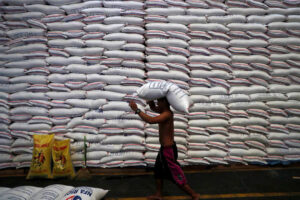ASIA-PACIFIC countries must build up their reserves of rice while ensuring there is no market abuse to take advantage of shortages, the Asian Development Bank (ADB) said.
“To address these challenges, governments and stakeholders must adopt a multifaceted approach that addresses both short- and medium-term concerns,” Pilipinas F. Quising, senior economics officer, and Shiela Camingue-Romance, economics officer at the ADB Macroeconomics Research Division, said in a blog.
“Consistently adopting a reactive rather than proactive approach often results in short-term fixes that can worsen long-term problems,” they said.
Rice is a major staple in the Asia-Pacific, where the Philippines is projected to remain the world’s biggest rice importer next year, according to the US Department of Agriculture (USDA).
The commodity accounts for up to 70% of daily caloric intake and a major share of the food price basket across Asia.
Global rice prices have risen 38% between December 2022 and December 2023, the bank said. “Despite a slight decline to an average of $613/metric ton in March, prices remain 29% higher than they were a year ago,” the ADB said.
Continued shocks from the El Niño weather phenomenon have also yet to become apparent in the region, it added.
“The persistence of El Niño until the second quarter, coupled with the possibility of transitioning into La Niña later in the year, poses continued risks to rice production.”
To curb risks to rice supply and prices, the government must strengthen market transparency and monitoring to prevent price manipulation and hoarding, the ADB said. It must provide targeted subsidies to vulnerable populations.
President Ferdinand R. Marcos, Jr. has yet to sign a bill seeking harsher sanctions against agricultural hoarding, smuggling, and other forms of market abuse.
Asia-Pacific countries must also build up rice reserves to ensure steady supply and dampen volatile prices in the medium term, Ms. Quising and Ms. Camingue-Romance said.
“However, efficient management, transparency, and proper storage and distribution infrastructure are crucial for ensuring effectiveness, preventing corruption and spoilage, and guaranteeing quality and accessibility of the reserved rice,” they added.
Philippine rice inflation eased slightly to 23.9% in April after peaking at 24.4% in March, the Philippine Statistic Authority reported.
Governments should also invest in modern agricultural technology and infrastructure, and push for crop diversification to strengthen resilience against climate shocks, Ms. Quising and Ms. Camingue-Romance said.
Damage to agriculture caused by the El Niño dry spell has topped P9.5 billion, the Philippines’ Department of Agriculture (DA) said last month.
Countries must also share best practices and ensure open trade to better manage rice supply and prices in the region.
The Department of Finance is studying a proposal to cut tariffs on rice imports to 17.5% or 20% from the current 35% rate.
“Countries in Asia and the Pacific can effectively foster stable and sustainable rice markets by promoting international collaboration, sharing knowledge, implementing focused interventions, and using financial assistance and technical expertise from their partners,” the ADB said.
Regular-milled rice was selling for P49.55 a kilo and well-milled rice P51.42, according to DA price monitors. Imported well milled rice was P52.98/kilo. — Beatriz Marie D. Cruz
